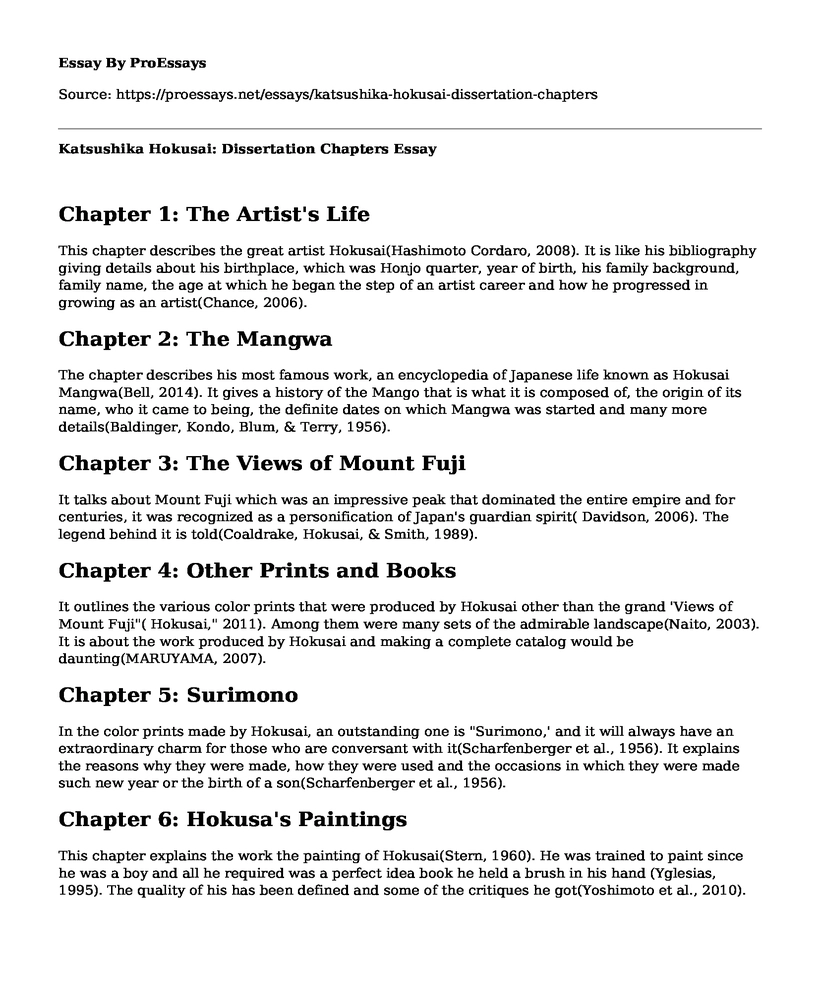Chapter 1: The Artist's Life
This chapter describes the great artist Hokusai(Hashimoto Cordaro, 2008). It is like his bibliography giving details about his birthplace, which was Honjo quarter, year of birth, his family background, family name, the age at which he began the step of an artist career and how he progressed in growing as an artist(Chance, 2006).Chapter 2: The Mangwa
The chapter describes his most famous work, an encyclopedia of Japanese life known as Hokusai Mangwa(Bell, 2014). It gives a history of the Mango that is what it is composed of, the origin of its name, who it came to being, the definite dates on which Mangwa was started and many more details(Baldinger, Kondo, Blum, & Terry, 1956).
Chapter 3: The Views of Mount Fuji
It talks about Mount Fuji which was an impressive peak that dominated the entire empire and for centuries, it was recognized as a personification of Japan's guardian spirit( Davidson, 2006). The legend behind it is told(Coaldrake, Hokusai, & Smith, 1989).
Chapter 4: Other Prints and Books
It outlines the various color prints that were produced by Hokusai other than the grand 'Views of Mount Fuji"( Hokusai," 2011). Among them were many sets of the admirable landscape(Naito, 2003). It is about the work produced by Hokusai and making a complete catalog would be daunting(MARUYAMA, 2007).
Chapter 5: Surimono
In the color prints made by Hokusai, an outstanding one is "Surimono,' and it will always have an extraordinary charm for those who are conversant with it(Scharfenberger et al., 1956). It explains the reasons why they were made, how they were used and the occasions in which they were made such new year or the birth of a son(Scharfenberger et al., 1956).
Chapter 6: Hokusa's Paintings
This chapter explains the work the painting of Hokusai(Stern, 1960). He was trained to paint since he was a boy and all he required was a perfect idea book he held a brush in his hand (Yglesias, 1995). The quality of his has been defined and some of the critiques he got(Yoshimoto et al., 2010).
Chapter 7: The Artist and the Man
It explains the artist and the man. A symbol exposes the secret of the entire thing that the artist himself attache to his residence (Zausner, n.d).
References
Baldinger, W. S., Kondo, I., Blum, P. C., & Terry, C. S. (1956). Katsushika Hokusai. The Journal of Asian Studies, 16(1), 151. doi:10.2307/2941569
Bell, D. (2014). Katsushika Hokusai and a Poetics of Nostalgia. Educational Philosophy and Theory, 47(6), 579-595. doi:10.1080/00131857.2014.964158
Chance, F. (2006). Frank L. Chance. Review of "Hokusai" by Ann Yonemura. caa.reviews. doi:10.3202/caa.reviews.2006.41
Coaldrake, W. H., Hokusai, K., & Smith, H. D. (1989). Hokusai: One Hundred Views of Mt. Fuji. The Journal of Asian Studies, 48(3), 618. doi:10.2307/2058676
Davidson, C. N. (2006). 36 Views of Mount Fuji. doi:10.1215/9780822388180
Hashimoto Cordaro, M. N. (2008). Um estudo de livro-pintura erotico: Manpuku Wagojin de Katsushika Hokusai (deuses da harmonia e da extrema felicidade). Revista Iberoamericana de Estudios de Asia Oriental, 1(1), 77-122. doi:10.3994/rieao.2008.01.077
Hokusai. (2011). Benezit Dictionary of Artists. doi:10.1093/benz/9780199773787.article.b00088793
MARUYAMA, S. (2007). Mt. Fuji between Two Great Waves by Katsushika Hokusai (1831-1833). Journal of Geography (Chigaku Zasshi), 116(1), Plate1-Plate2. doi:10.5026/jgeography.116.plate1
Naito, M. (2003). Katsushika Hokusai. Oxford Art Online. doi:10.1093/gao/9781884446054.article.t046003
Scharfenberger, F., Grilli, E., Kondo, I., Kondo, I., Blum, P. C., Takahashi, S., & Terry, C. S. (1956). Kodansha Library of Japanese Art. No. 1: Katsushika Hokusai. Monumenta Nipponica, 11(4), 449. doi:10.2307/2382988
Scharfenberger, F., Grilli, E., Kondo, I., Kondo, I., Blum, P. C., Takahashi, S., & Terry, C. S. (1956). Kodansha Library of Japanese Art. No. 1: Katsushika Hokusai. Monumenta Nipponica, 11(4), 449. doi:10.2307/2382988
Stern, H. P. (1960). Hokusai: paintings and drawings in the Freer Gallery of Art. doi:10.5479/sil.861641.39088016762775
Yglesias, J. (1995). "El ultimo invierno de hokusai". Chasqui, 24(1), 119. doi:10.2307/29741206
Yoshimoto, M., Fujii, T., Kaneko, T., Yasuda, A., Nakada, S., & Matsumoto, A. (2010). Evolution of Mount Fuji, Japan: Inference from drilling into the subaerial oldest volcano, pre-Komitake. Island Arc, 19(3), 470-488. doi:10.1111/j.1440-1738.2010.00722.x
Zausner, T. (n.d.). Katsushika Hokusai: The Old Man Mad About Painting. PsycEXTRA Dataset. doi:10.1037/e654652011-001
Cite this page
Katsushika Hokusai: Dissertation Chapters. (2022, Apr 02). Retrieved from https://proessays.net/essays/katsushika-hokusai-dissertation-chapters
If you are the original author of this essay and no longer wish to have it published on the ProEssays website, please click below to request its removal:
- Rhetorical Analysis of Banksy's Exit Through the Gift Shop Documentary
- Classification of Music: Essay Sample
- Fictional Archetype or Trope Essay
- Singin' in the Rain: A Classic Musical Comedy From 1952 - Essay Sample
- Bach's Musical Journey: Exploring Chromatic Fantasies - Essay Sample
- Paper Example on Lil Uzi Vert's Eternal Atake: A Milestone in Hip-Hop History
- Analytical Essay Sample on the Importance of Reading for a Writer







